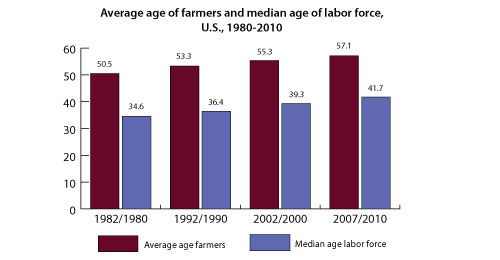The U.S. farm population is aging. This isn't news to anyone in the agricultural community; it is our reality. The age of U.S. farmers and the impending need to replace them is a recurring topic of discussion.
But, Ohio State professor Carl Zulauf, has a fresh perspective on agriculture's future. In his paper "Putting the age of U.S. farmers in perspective," Zulauf examines changes in the average age of U.S. farmers over time. He then compares this to the age of the U.S. labor force. The conclusion: farmers aren't the only population sector that's aging.
Age of the U.S. farmer
Average age was first reported in the 1945 census of agriculture at 48.5 years. At the latest census (2007), our nation's farmers averaged 57.1 years. Over this 62-year span, farmer's average age rose 8.4 years or 17 percent.
Most notably, the share of producers 65 and older has grown from 14 percent in 1945 to 30 percent in 2007.
The only true decline in average age occurred during the mid to late 1970s. Zulauf speculates that this temporary reduction resulted from the farm prosperity boom at the end of that decade.
How the labor force trends
The average age of U.S. farmers in 2007 exceeded the 2010 median age of the labor force by just over 15 years. This difference has not changed much since 1980, implying that U.S. farmers and the labor force are aging in concert. If anything, added Zulauf, farmers are aging somewhat slower.

The largest discrepancy between the two sectors was the percent of the workforce 65 and over. In 2010, only 4 percent of the overall labor force fell into this age bracket, 10 percent less than their farming cohorts.
Zulauf concluded that even though the farm population is aging, it mirrors that of the U.S. labor force. While the farming populace is older than the labor force, this trend has existed for decades. The older average age of farmers is consistent with farming being capital intensive industry.
While a great deal has been written about the need to bring young blood into the profession, the 1970 period of farm prosperity suggests that a similar influx could take place in the coming years. This resurgence will likely occur over many years and its magnitude will depend on the staying power of current farm prosperity.

The author, Amanda Smith, was an associate editor and is an animal science graduate of Cornell University. Smith covers feeding, milk quality and heads up the World Dairy Expo Supplement. She grew up on a Medina, N.Y., dairy, and interned at a 1,700-cow western New York dairy, a large New York calf and heifer farm, and studied in New Zealand for one semester.
But, Ohio State professor Carl Zulauf, has a fresh perspective on agriculture's future. In his paper "Putting the age of U.S. farmers in perspective," Zulauf examines changes in the average age of U.S. farmers over time. He then compares this to the age of the U.S. labor force. The conclusion: farmers aren't the only population sector that's aging.
Age of the U.S. farmer
Average age was first reported in the 1945 census of agriculture at 48.5 years. At the latest census (2007), our nation's farmers averaged 57.1 years. Over this 62-year span, farmer's average age rose 8.4 years or 17 percent.
Most notably, the share of producers 65 and older has grown from 14 percent in 1945 to 30 percent in 2007.
The only true decline in average age occurred during the mid to late 1970s. Zulauf speculates that this temporary reduction resulted from the farm prosperity boom at the end of that decade.
How the labor force trends
The average age of U.S. farmers in 2007 exceeded the 2010 median age of the labor force by just over 15 years. This difference has not changed much since 1980, implying that U.S. farmers and the labor force are aging in concert. If anything, added Zulauf, farmers are aging somewhat slower.

The largest discrepancy between the two sectors was the percent of the workforce 65 and over. In 2010, only 4 percent of the overall labor force fell into this age bracket, 10 percent less than their farming cohorts.
Zulauf concluded that even though the farm population is aging, it mirrors that of the U.S. labor force. While the farming populace is older than the labor force, this trend has existed for decades. The older average age of farmers is consistent with farming being capital intensive industry.
While a great deal has been written about the need to bring young blood into the profession, the 1970 period of farm prosperity suggests that a similar influx could take place in the coming years. This resurgence will likely occur over many years and its magnitude will depend on the staying power of current farm prosperity.

The author, Amanda Smith, was an associate editor and is an animal science graduate of Cornell University. Smith covers feeding, milk quality and heads up the World Dairy Expo Supplement. She grew up on a Medina, N.Y., dairy, and interned at a 1,700-cow western New York dairy, a large New York calf and heifer farm, and studied in New Zealand for one semester.








